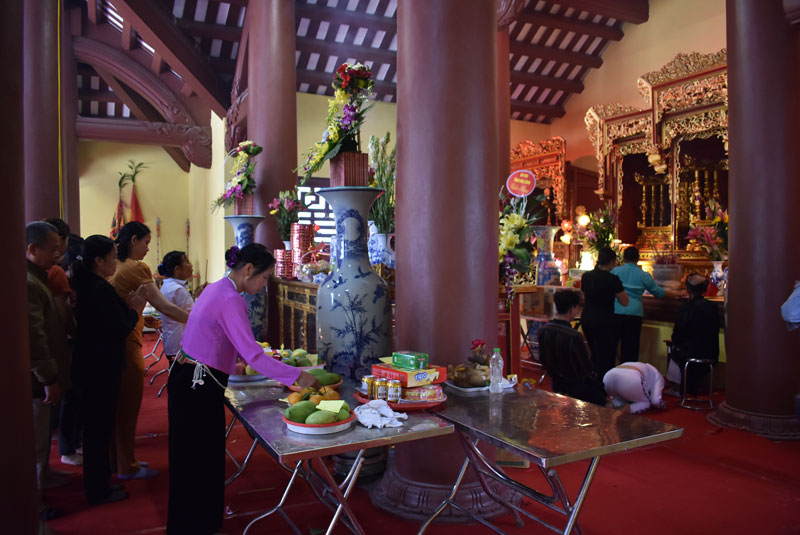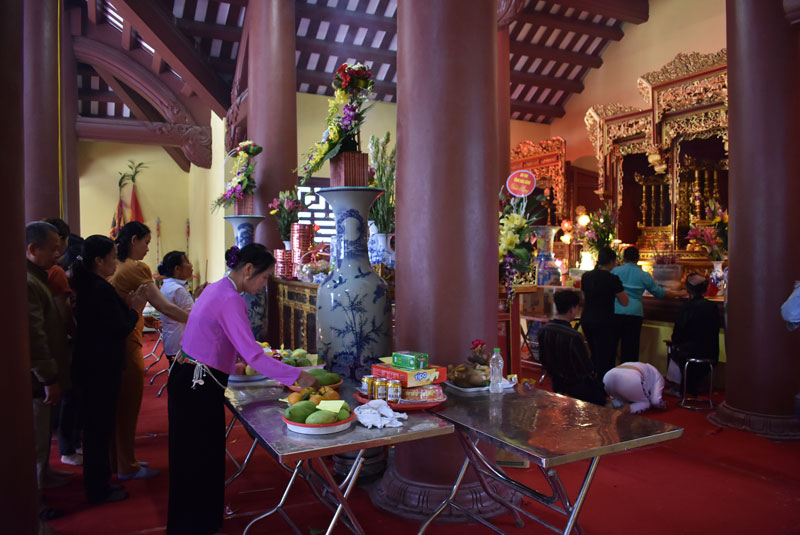
(HBO) - Historically, Quen Thi village in Cao Duong commune, Luong Son district was born a few hundred years ago. At first, there were only seven households from other places to settle here. Later, it developed into a village called Trai Mit village, which is now called Quen Thi village. About 300 years ago, the people of Quen Thi village built a communal house to worship the Gods Tan Vien Son, Cun Truong Thung, and the Citadel of the village.
Quen Thi Communal House in Cao Duong commune (Luong Son) was built nicely, meeting the spiritual needs of the local people.
It is not only is a religious place, the village communal house is also a meeting place to discuss the village’s matters. The communal house was built in the middle of the field, looking the south. In the east, west and north there are limestone mountains that cover the village campus. Quen Thi communal house has been expanded into seven compartments, with a harem and it was built with precious wooden. The communal house was degraded over the time. In 1996, the people of Quen Thi village contributed their labor and money to rebuilding the communal house at the right old place to worship the gods, Tan Vien Son and the Citadel of the village.
During the year, Quen Thi communal house often holds five main festivals, in which the spring festival on the 12th of January is held the most solemnly. The festival includes the ceremony to hold the palanquin procession of Duc Mau's incense bowl to the eldest communal house. After the ceremony stopped at the right place, the folk games, antiphonal singing, cultural and sports activities take place. These activities always attract the people of the whole village to participate. On April 4 of the lunar calendar, the communal house held a ceremony to pray for water plating. The village’s shaman prays for good rain, good weather and good crops. On 12 June of the lunar calendar is a ceremony to go to the field. The village’s shaman prays the gods, the heaven and earth for the permission to go to the field. After the ceremony, the villagers are allowed to go transplanting in the fields. The 18th August of lunar month is a ceremony to wash rice leaves. At this time, rice is standing and easily being damaged by pests and other diseases. The people in the village pray for good weather and no pests and diseases can destroy the crops. On the 12th of October, the new rice ceremony is celebrated. At this time, rice begins to be collected home. This is a ceremony to thank the gods, the heaven and earth to have helped them with the good harvest, the prosperous and healthy business and good health.
With an increasingly vibrant and widespread emulation movement aimed at building cultured residential areas and cultured families, Yen Thuy District has been making steady progress toward improving both the material and spiritual well-being of its people, while fostering a civilized, prosperous, beautiful, and progressive community.
Once lacking recreational spaces and community facilities, Residential Group 2 in Quynh Lam Ward (Hoa Binh City) has recently received attention for the construction of a new, spacious, and fully equipped cultural house. The project followed the model of state support combined with public contributions in both labor and funding.
The "All people unite to build cultural life" movement, which has been effectively integrated with Kim Boi district’s socio-economic development goals, is fostering a lively spirit of emulation across local residential areas, hamlets, villages, public agencies, and enterprises. In addition, through the initiative, traditional cultural values are being preserved and promoted, while community solidarity and mutual support in poverty reduction and economic development are being strengthened.
A working delegation of the Hoa Binh provincial People’s Committee led by its Permanent Vice Chairman Nguyen Van Toan on June 11 inspected the progress of a project to build the Mo Muong Cultural Heritage Conservation Space linked to tourism services in Hop Phong commune, Cao Phong district.
Born and growing in the heroic land of Muong Dong, Dinh Thi Kieu Dung, a resident in Bo town of Kim Boi district, in her childhood was nurtured by the sweet lullabies of her grandmother and mother. These melodies deeply imprinted on her soul, becoming an inseparable part of her love for her ethnic group's culture. For over 20 years, this love for her hometown has driven Dung to research, collect, and pass down the cultural values of the Muong people to future generations.
In the final days of May, the Ethnic Art Troupe of Hoa Binh Province organized performances to serve the people in remote, mountainous, and particularly disadvantaged areas within the province. These were not just ordinary artistic shows, but they were the meaningful journeys aimed at spreading cultural values, enhancing the spiritual life of the people and contributing to the preservation of ethnic minority cultural identities.



